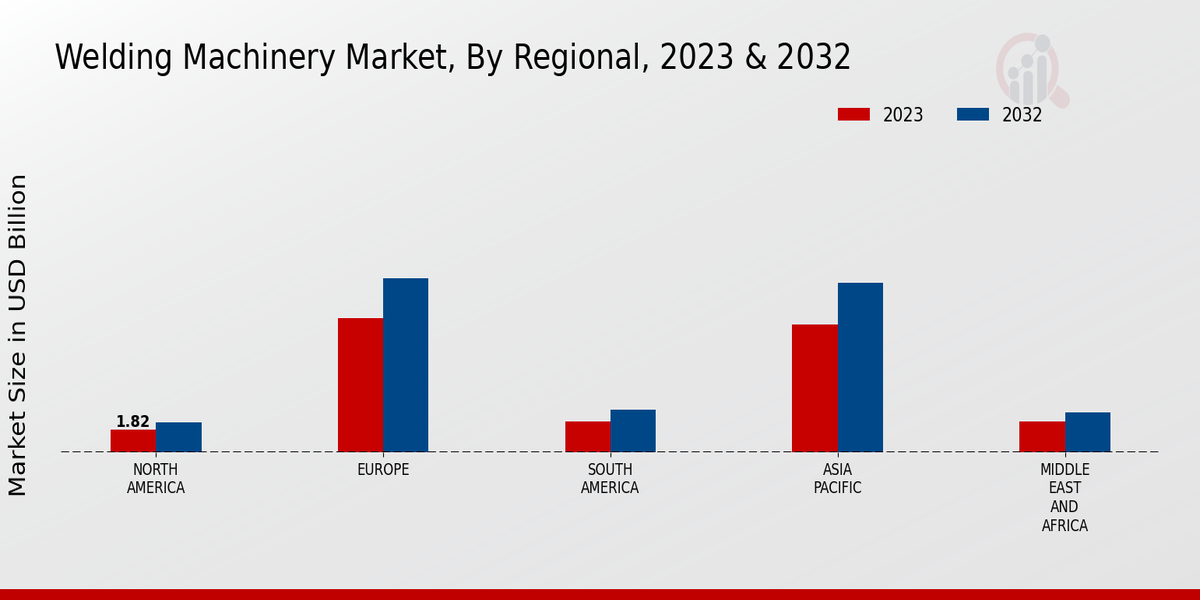Market Growth Projections
The Global Welding Machinery Market Industry is poised for substantial growth, with projections indicating a market size of 13.9 USD Billion in 2024 and an anticipated increase to 18.8 USD Billion by 2035. This growth trajectory suggests a compound annual growth rate of 2.73% from 2025 to 2035. The increasing demand for advanced welding technologies across various sectors, including automotive, construction, and manufacturing, is likely to drive this expansion. As industries continue to evolve and adopt innovative welding solutions, the market is expected to witness significant developments in the coming years.
Technological Advancements
The Global Welding Machinery Market Industry is experiencing a notable transformation due to rapid technological advancements. Innovations such as automated welding systems, robotics, and advanced welding techniques are enhancing productivity and precision. For instance, the integration of artificial intelligence in welding processes is streamlining operations and reducing human error. As a result, manufacturers are increasingly adopting these technologies to improve efficiency and reduce costs. The market is projected to reach 13.9 USD Billion in 2024, reflecting the growing demand for sophisticated welding solutions that meet the evolving needs of various industries.
Growing Adoption of Automation
The growing adoption of automation in manufacturing processes is reshaping the Global Welding Machinery Market Industry. Companies are increasingly recognizing the benefits of automated welding systems, which enhance efficiency and reduce labor costs. Automation not only improves production rates but also ensures consistent quality in welding operations. As industries strive for greater competitiveness, the shift towards automated solutions is becoming more pronounced. This trend is expected to contribute to a compound annual growth rate of 2.73% from 2025 to 2035, indicating a robust future for automated welding technologies.
Rising Demand from Automotive Sector
The automotive sector plays a pivotal role in driving the Global Welding Machinery Market Industry. With the continuous production of vehicles and the increasing complexity of automotive designs, the demand for advanced welding machinery is surging. Manufacturers are investing in high-performance welding equipment to ensure structural integrity and safety in vehicles. This trend is expected to contribute significantly to the market's growth, with projections indicating a rise to 18.8 USD Billion by 2035. The automotive industry's shift towards electric vehicles further amplifies the need for innovative welding technologies, as these vehicles often require specialized welding processes.
Infrastructure Development Initiatives
Infrastructure development initiatives across various regions are significantly influencing the Global Welding Machinery Market Industry. Governments are investing heavily in infrastructure projects, including bridges, roads, and buildings, which require robust welding solutions. The demand for durable and high-quality welding machinery is expected to rise as these projects progress. This trend is particularly evident in emerging economies where urbanization is accelerating. The market's growth trajectory is likely to be bolstered by these initiatives, as the need for reliable welding equipment becomes increasingly critical in supporting large-scale construction efforts.
Environmental Regulations and Sustainability
The Global Welding Machinery Market Industry is also being driven by increasing environmental regulations and a growing emphasis on sustainability. Manufacturers are under pressure to adopt eco-friendly practices, leading to the development of welding technologies that minimize emissions and energy consumption. Innovations such as low-energy welding processes and the use of sustainable materials are gaining traction. As industries strive to meet regulatory requirements and consumer expectations for sustainability, the demand for environmentally friendly welding solutions is likely to rise. This shift not only aligns with global sustainability goals but also presents new opportunities for market growth.



















Leave a Comment